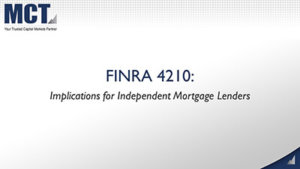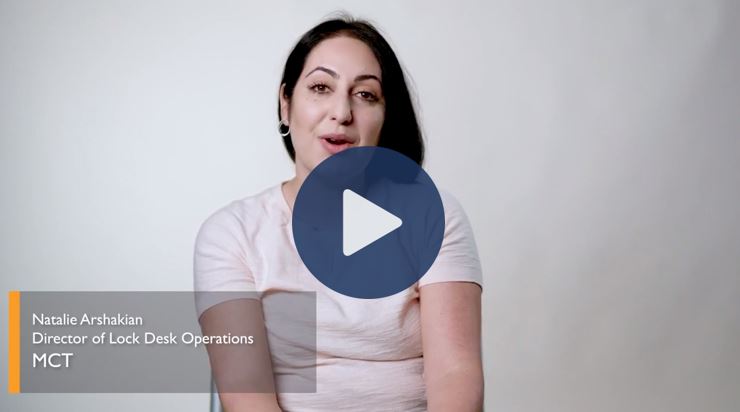 In this full video recap of a previous MCT webinar, you can be confident in answering the question, “What does the FINRA 4210 Mark to Market Rule mean for Lenders?” by watching this webinar presented by Glen Corso, Executive Director of the CMLA, and Phil Rasori, Chief Operating Officer of MCT.
In this full video recap of a previous MCT webinar, you can be confident in answering the question, “What does the FINRA 4210 Mark to Market Rule mean for Lenders?” by watching this webinar presented by Glen Corso, Executive Director of the CMLA, and Phil Rasori, Chief Operating Officer of MCT.
Starting June 25, 2018, if your company’s net mark to market position on covered agency transactions is more than negative $250,000 on a daily basis, then this FINRA rule will apply to you.
On November 2017, Phil Rasori led a complimentary educational webinar discussing many important changes to the Financial Industry Regulatory Authority (FINRA) Mark to Market Rule 4210. Organized by Glen Corso, executive director at Community Mortgage Lenders of America (CMLA), the webinar left lenders with a good understanding of the rule details, how it will affect their businesses, and how to prepare for it.
What are the changes to the FINRA Rule 4210?
According to FINRA Regulatory Notice 16-31, amendments to Rule 4210 will establish margin requirements for Covered Agency Transactions, including the TBA transactions central to MCT pipeline hedging strategies. FINRA members will be required to collect daily MTM margin from all counterparties on these transactions. However, the margin is not required to be collected or charged to net capital if the aggregate required but uncollected MTM loss does not exceed $250,000.
Starting June 25, 2018 if your company’s net mark to market position on covered agency transactions is more than negative $250,000 on a daily basis, your FINRA registered broker dealer will be required to collect the amount that exceeds $250,000 from you. This change is a result of a rules change by the Financial Industry Regulatory Authority (FINRA) that regulates most broker-dealers in the U.S.
FINRA Statement on policy of calling and returning MTM Margin:
“if the collateral that the member receives from the counterparty reduces the mark to market loss or deficiency to an amount that is below the $250,000 de minimis transfer amount, prior to the specified five business day period, and the remaining uncollected amount, as a matter of the member’s policies and procedures, is within the member’s risk tolerance and counterparty exposure limits, then the member may treat the margin call as satisfied and, under the amendments, liquidation is not required”
FINRA Rule 4210 Webinar with Glen Corso and Phil Rasori
This video recap of the full webinar with Glen Corso, Executive Director of the CMLA, and Phil Rasori, Chief Operating Officer at Mortgage Capital Trading, Inc. (MCT) gathers a comprehensive understanding of what you need to know about this new rule, what it will mean for your company, and what you can do to minimize any negative impact to your company from the rule.
WHY JOIN CMLA? – “The Community Mortgage Lenders of America ensures that the voice of the community mortgage lender is heard in Washington, as the industry undergoes a constant state of regulation. We give lenders direct access to the nation’s top experts on legal and regulatory issues; and provide mortgage lenders with timely and accurate information on new and changing regulatory requirements. Join forces with your colleagues nationwide to help CMLA raise the bar to ensure your business and community lending concerns are heard and addressed – before, not after, laws are made.” – To join CMLA contact Executive Director Glen Corso at 202.827.9989 / gcorso@thecmla.com
Notable highlights from the presentation:
- A total of $250k (both open and closed) negative exposure will result in a mark to market (MTM) call.
- Once the negative exposure has receded below $250k, the release of the MTM call funds back to the lender is at the discretion of the respective broker dealer until the total exposure has fallen to zero.
- For lenders that currently have “maintenance margin” outstanding with a broker dealer, the dealer will need to be contacted and asked whether or not MTM margin calls will be allowed to be netted out from the current maintenance margin account. This is up to the dealer’s discretion and will probably be decided on an individual basis.
- The rule allows for bilateral margin arrangements where positive open exposure is wired to the lender. While this is not standard practice within the broker dealer community, we believe that this new margining rule will provide leverage for clients to ask for symmetrical bilateral arrangements.
- The Fannie Mae Trade Desk is exempt from this rule.
Contact us if you have any more questions about navigating these complex markets or you can learn more from the mortgage hedge advisory services page on our website. We can help find profitable and effective solutions for any size lenders. Thanks for reading our blog on FINRA 4210 rule changes.



